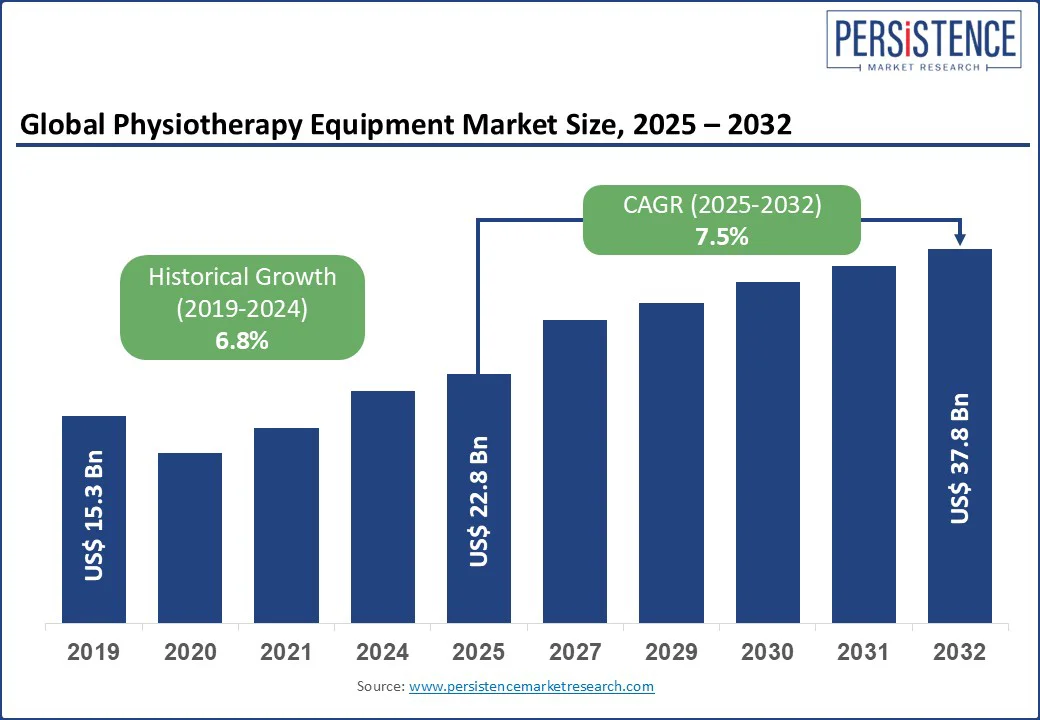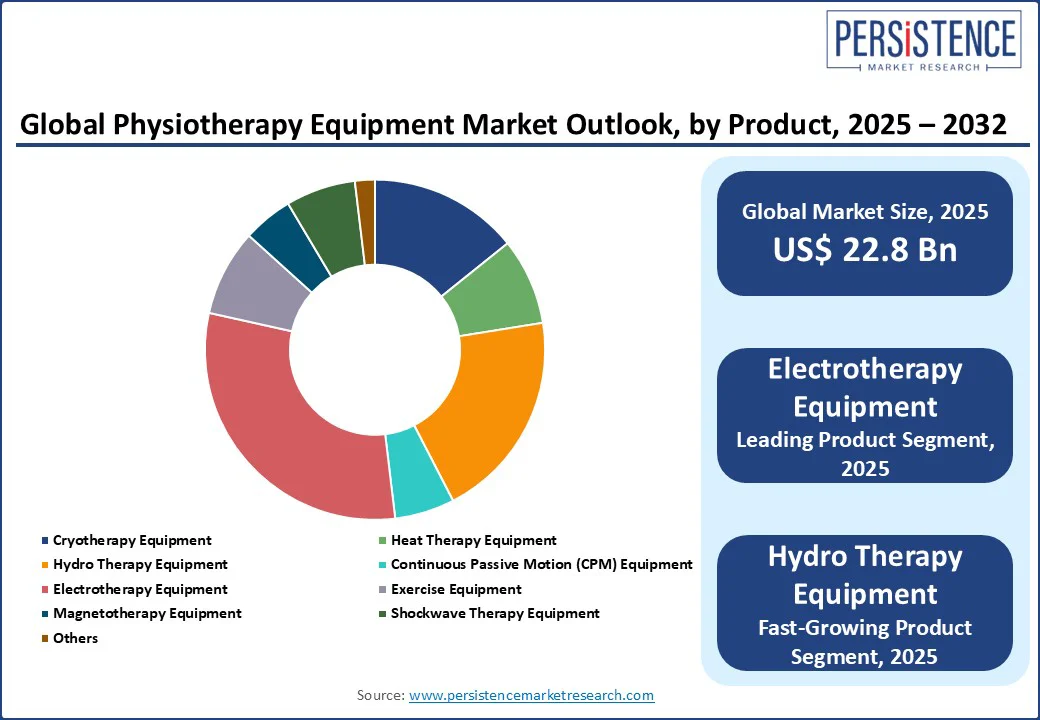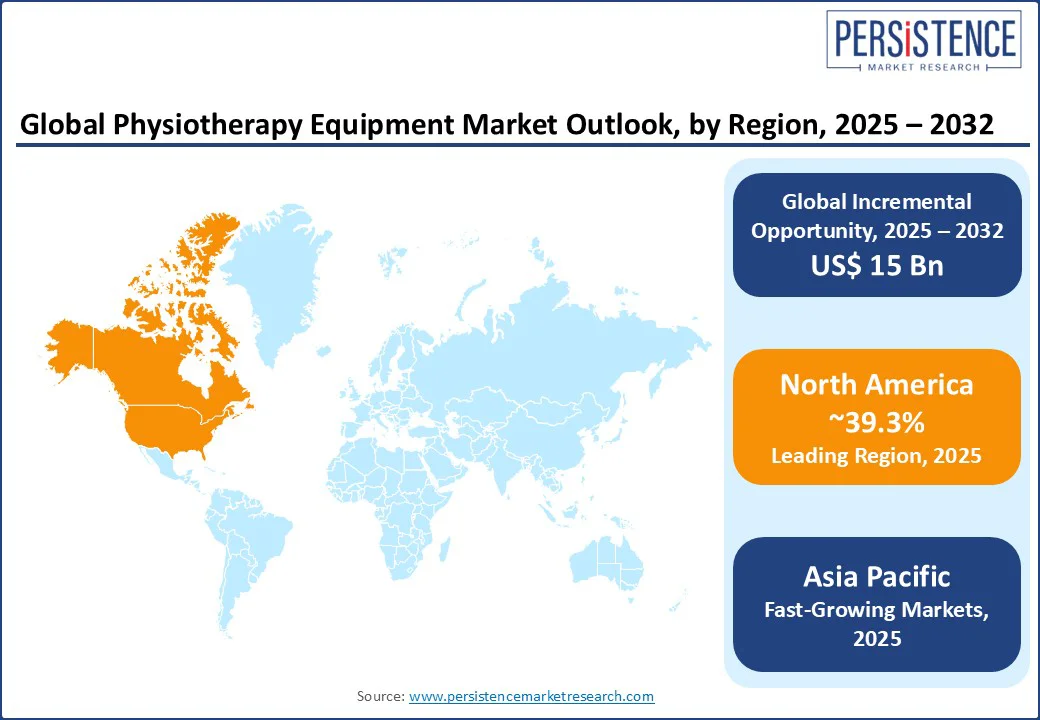ID: PMRREP3209| 192 Pages | 11 Aug 2025 | Format: PDF, Excel, PPT* | Healthcare

The global physiotherapy equipment market size is projected to rise from US$ 22.8 Bn in 2025 to US$ 37.8 Bn by 2032. It is anticipated to witness a CAGR of 6.8% during the forecast period from 2025 to 2032. The global physiotherapy equipment market is largely driven by the increasing prevalence of musculoskeletal, neurological, and cardiopulmonary conditions, which affect approximately 1.71 billion people worldwide. Musculoskeletal issues are the leading cause of disability, with low back pain being the most significant contributor to disability in 160 countries. Physiotherapy equipment is essential in hospitals, clinics, and homecare settings, as it helps restore mobility and improve patient outcomes.

Key Industry Highlights:
|
Global Market Attribute |
Key Insights |
|
Physiotherapy Equipment Market Size (2025E) |
US$ 22.8 Bn |
|
Market Value Forecast (2032F) |
US$ 37.8 Bn |
|
Projected Growth (CAGR 2025 to 2032) |
6.8% |
|
Historical Market Growth (CAGR 2019 to 2024) |
7.5% |
As patients and healthcare providers increasingly prioritize safer, low-risk recovery methods, the demand for non-invasive physiotherapy solutions continues to rise. Physiotherapy equipment is becoming the preferred choice for managing chronic pain, post-surgical rehabilitation, and neurological disorders. In 2020, chronic lower back pain affected an estimated 619 million people globally, and this number is projected to reach 843 million by 2050, according to the European Pain Federation and the WHO. Additionally, 83% of patients using digital physiotherapy platforms report significant pain reduction without surgery, highlighting the growing clinical acceptance of these technologies.
In March 2023, Zynex Inc. launched NexWave, an advanced electrotherapy device offering 50 times stronger pain relief than standard TENS units, designed for home use and recommended by clinicians for post-surgical and chronic pain rehabilitation. As the global healthcare focus shifts toward preventive care and functional recovery, the adoption of physiotherapy equipment is expanding rapidly across outpatient clinics, rehabilitation centers, and home-based settings, thereby positioning it as a vital component of modern rehabilitation strategies.
Many countries, particularly low- and middle-income regions, face significant shortages of trained physiotherapists and professionals skilled in operating advanced physiotherapy technologies such as electrotherapy units, hydrotherapy systems, CPM machines, and specialized exercise equipment. This lack of expertise severely hampers the delivery of effective, evidence-based rehabilitation care.
In addition, inadequate academic infrastructure, limited access to continuing education, and the absence of standardized certification programs further contribute to the skill deficit. Rural and underserved areas are disproportionately affected, where even basic physiotherapy services are scarce. These challenges limit the widespread adoption and the clinical impact of physiotherapy equipment.
The rapid expansion of homecare settings and innovations in remote physiotherapy technologies present major growth opportunities for manufacturers of compact physiotherapy devices. As patients increasingly seek convenient, cost-effective, and personalized rehabilitation options, portable tools that enable remote monitoring, guided exercise therapy, and home-based electrotherapy are being adopted at a growing pace. This shift is especially prominent among aging populations, post-operative patients, and individuals with mobility constraints who prefer recovery in home environments.
The U.K.-based Hydro Physio launched its Active Hydrotherapy Trainer at Arab Health 2023—a compact aquatic treadmill system supporting personalized joint- and weight-bearing rehabilitation at home. Such innovations reflect a broader push toward decentralizing physiotherapy services while maintaining clinical effectiveness. Manufacturers focusing on connectivity, portability, and tele-rehabilitation integration are poised to lead this growing market segment.
Electrotherapy equipment is anticipated to dominate with a 32.3% market share in 2025, driven by its proven efficacy in managing pain, promoting neuromuscular re-education, and enhancing post-injury. Devices such as Transcutaneous Electrical Nerve Stimulation (TENS), Interferential Current Therapy (IFC), and Neuromuscular Electrical Stimulation (NMES) are widely used across clinical and homecare settings to treat conditions such as chronic back pain, muscle atrophy, and nerve injuries.
The technology’s non-invasive nature and ability to stimulate muscle function and circulation make it particularly valuable for orthopedic and neurological rehabilitation. In November 2023, MANAMED launched the ManaFlexx 2, a compact, FDA-cleared EMS device that combines TENS and NMES functionalities in a wireless, OTC format for home-based use. With the growing demand for opioid alternatives and drug-free pain relief, electrotherapy remains a preferred modality in modern physiotherapy protocols.
Orthopedic rehabilitation is projected to lead with a 60.3% market share in 2025, driven by the growing burden of fractures, joint degeneration, and sports-related injuries. According to the International Osteoporosis Foundation, up to 37 million fragility fractures occur annually in individuals aged 55 and above, equivalent to 70 fractures every minute, highlighting the rising need for structured rehabilitation. Moreover, the American Academy of Orthopedic Surgeons projects that knee arthroplasty procedures in the U.S. will reach 3.48 million annually by 2030, highlighting the surge in joint replacement surgeries.
Evome Medical Technologies (formerly Salona Global) introduced the Biodex SpaceTek Knee™ device in November 2023, a portable isokinetic knee dynamometer co-developed with NASA, housed in a case under 70 lb, for post-operative knee rehabilitation in clinics and homes. These developments reinforce the critical role of advanced physiotherapy equipment, such as CPM machines, electrotherapy units, and resistance tools, in supporting recovery and mobility in orthopedic care.

North America remains at the forefront with a market share of 39.3% in 2025, supported by robust infrastructure, technological leadership, and growing rehabilitation needs. In the U.S., providers tackle a high volume of orthopedic interventions; according to the American College of Rheumatology, approximately 790,000 knee and 450,000 hip replacements are performed each year, driving demand for post-operative physiotherapy tools.
In May 2024, Richmar launched the REX Four-Tiered Sequential Leg Compression System in the U.S., enhancing recovery and circulation in both home and clinical environments. In parallel, the rise of tele-rehabilitation, with remote PT sessions integrating AI tools, is fueling the adoption of connected, patient-centric equipment. Supported by favorable reimbursement and outpatient care models, North America is evolving into a key hub for advanced physiotherapy equipment and services.
The Asia Pacific market is gaining momentum, propelled by increasing neurological rehabilitation needs and digital innovation. China registers over 2 million new stroke cases annually, intensifying demand for connected recovery solutions. In May 2023, Singapore-based SynPhNe, in partnership with Indegene, launched its Synergistic Physio Neuro Platform, a non-invasive wearable combining brain and muscle stimulation in a single device for remote therapy.
At the World Physiotherapy Asia Pacific Congress in Bali in September 2024, Techcare Innovation showcased its FIBOD Digital Balance Board and Hand Robotic Training Device, highlighting the region’s focus on digital, game-like rehabilitation tools. With the ongoing telestroke network expansion in countries such as Thailand and Malaysia, there is a growing need for compact, connected physiotherapy tools. These regional initiatives, which blend neurology, wearable tech, and digital platforms, signal Asia Pacific’s rise in the global physiotherapy equipment ecosystem.
Europe’s market is growing steadily due to its aging population, chronic disease burden, and increasing shift toward preventive care. According to Eurostat, over 21% of the EU population is aged 65 and older, a figure expected to reach 29% by 2050. These demographics drive demand for rehabilitation tools targeting age-related mobility issues and chronic musculoskeletal pain.
Storz Medical unveiled its MASTERPULS® ultra and MAGNETOLITH® ultra devices at REHACARE 2024 in Germany, enhancing non-invasive orthopedic and sports rehabilitation. Meanwhile, the U.K.’s NHS piloted an AI-powered physiotherapy clinic in 2024 to reduce patient wait times and expand access. These developments, along with increased adoption of connected and home-based rehab systems, are transforming the landscape of physiotherapy across Europe.

The global physiotherapy equipment market is moderately fragmented, with competition driven by innovations in electrotherapy, exercise therapy, and connected rehabilitation devices. Key players compete by introducing compact, user-friendly, and AI-integrated systems tailored for clinical and homecare use. Companies are investing heavily in R&D to develop non-invasive, multi-modality platforms that support personalized rehabilitation programs.
The growing emphasis on tele-rehabilitation and remote patient monitoring is encouraging partnerships with digital health providers. Competitive advantage increasingly hinges on regulatory approvals, technological adaptability, and distribution networks, particularly in emerging markets where demand is rising for portable, affordable solutions that improve patient outcomes across varied care settings.
The global physiotherapy equipment market is projected to be valued at US$ 22.8 Bn in 2025.
The physiotherapy equipment market is driven by increasing demand for non-invasive and drug-free rehabilitation solutions.
The physiotherapy equipment market is poised to witness a CAGR of 6.8% between 2025 and 2032.
Expanding homecare settings with remote physiotherapy solutions presents a strong growth opportunity for a compact physiotherapy manufacturer.
Major players include Enraf-Nonius B.V., EMS Physio Ltd., Enovis Corp., Dynatronics Corporation, and BTL Industries, Inc.
|
Report Attribute |
Details |
|
Historical Data/Actuals |
2019 - 2024 |
|
Forecast Period |
2025 - 2032 |
|
Market Analysis |
Value: US$ Bn |
|
Geographical Coverage |
|
|
Segmental Coverage |
|
|
Competitive Analysis |
|
|
Report Highlights |
|
|
Customization and Pricing |
Available upon request |
By Product
By Application
By End-user
By Region
Delivery Timelines
For more information on this report and its delivery timelines please get in touch with our sales team.
About Author